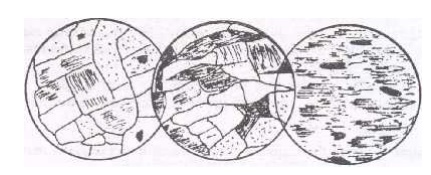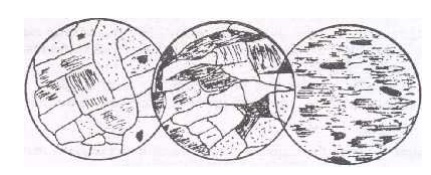Chapter: Civil : Engineering Geology : Petrology
Textures Of Igneous Rocks

TEXTURES OF IGNEOUS ROCKS
Ø
The term texture is defined as the mutual
relationship of different mineralogical constituents in a rock. It is
determined by the size, shape and arrangement of these constituents within the
body of the rock.
Factors Explaining Texture
The following three factors will primarily define
the type of texture in a given igneous
rock:
Degree of Crystallization
Ø In an
igneous rock, all the constituent minerals may be present in distinctly
crystallized forms and easily recognized by unaided eye, or, they may be poorly
crystallized or be even glassy or non- crystallized form.
Ø
The resulting rock textures are then described as:
(i)
Holocrystalline: When all the constituent
minerals are distinctly crystallized;
(ii) Holohyaline:
When all the constituents are very fine in size and glassy or non
crystalline in nature.
Ø
The term merocrystalline is commonly used
to express the intermediate type, i.e. when some minerals are
crystallized and others are of glassy character in the same rock.
Ø
Rocks with holocrystalline texture are also
termed as phaneric and the holohyaline rocks

are referred as aphinitic. The
term microcrystalline is used for the textures in which the minerals are
perceivably crystallized but in extremely fine grain.
Granularity
Ø
The grain size of the various components of a rock
are the average dimensions of different constituent minerals which are taken
into account to describe the grain size of the rock as a whole. Thus the rock
texture is described as :
(i)
Coarse-grained. When
the average grain size is above 5 mm; the constituent minerals
are then easily identified with naked eye.
(ii)
Medium-grained. When
the average grain size lies between 5 mm and 1 mm. Use of magnifying
lens often becomes necessary for identifying ail the constituent mineral
components.
(iii) Fine-grained. When
the average grain size is less than 1 mm. In such rocks, identification
of the constituent mineral grains is possible only with the help of microscope
for which very thin rock sections have to be prepared for microscopic studies
Fabric
Ø
This is a composite term expressing the relative
grain size of different mineral constituents in a rock as well as the degree of
perfection in the form of the crystals of the individual minerals.
Ø
The texture is termed as equigranular when all the
component minerals are of approximately equal dimensions and as inequigranular
when some minerals in the rock are exceptionally larger or smaller than the
other.
Ø Similarly,
the shape or form of the crystals, which is best seen only in thin sections
under microscope, may be described as perfect, semi perfect or totally
irregular. The textural terms to describe these shapes are, respectively,
euhedral, subhedral and anhedral.
Ø
An igneous rock may contain crystals of anyone
type in a predominating proportion;
hence its fabric will be defined by one of the following three
terms related to fabric:
(i)
Panidiomrphi: when
majority of the components are in fully developed shapes;
(ii)
Hypidiomorphic: the
rock contains crystals of all the categories: euhedral, subhedral or
anhedral;
(iii)
Allotriomorphic: when
most of the crystals are of anhedral or irregular shapes
Types of Textures
These can be broadly divided into five categories:
. Equigranular textures
. Inequigranular textures
. Directive textures
. Intergrowth textures and
. Intergranular textures.
(1)
Equigranular Textures
Ø
All those textures in which majority of
constituent crystals of a rock are broadly equal in size are described as
equigranular textures.
Ø
In igneous rocks, these textures are shown by
granites and felsites and hence are also often named as granitic and felsitic
textures
Ø
In the granitic
texture, the constituents
are either all
coarse grained or all
medium grained and the crystals show euhedral to subhedral
outlines.
Ø
In the felsitic texture, the rock is micro
granular, the grains being mostly microscopic crystals but these invariably
show perfect outlines.
Ø
Thus felsitic textures may be described as
equigranular and panidiomrphic.
Orthophyric texture is another type of
equigranular texture, which is in between
the granitic and felsitic textures.
The individual grains are fine in size but not micregranular.
(2)
Inequigranular Texture
Ø
Igneous textures in which the majority of
constituent minerals show marked difference in their relative grain size are
grouped as inequigranular texture.
Ø
Porphyritic and Poiklitic textures are important
examples of such textures.
Ø
Porphyritic Texture is characterised by the
presence of a few conspicuously large sized crystals
(the phenocrysts) which are
embedded in a fine-grained ground mass or matrix.
Ø
The texture is sometimes further distinguished
into mega-porphyritic and microporphyritic depending upon the size of the
phenocrysts.
Difference in. molecular concentration
Ø When the magma is rich in
molecules of particular mineral, the latter has better chance to grow into big
crystals which may get embedded in the fine-grained mass resulting from the
deficient components.
Change in physico-chemical conditions.
Ø
Every magma is surrounded by a set of
physico-chemical conditions like temperature, pressure and chemical
composition, which influence the trend of crystallisation greatly.
Ø
Abrupt and discontinuous changes in these textures
may result in the formation of the crystals of unequal dimensions.
Ø
Thus, magma crystallizing at great depths may
produce well-defined, large sized crystals.
Ø
When the same magma (carrying with it these large
crystals) moves upward, the pressure and temperature acting on it are greatly
reduced.
Ø
Crystallisation in the upper levels of magma
becomes very rapid resulting in a fine-grained matrix that contains the big
sized crystals formed earlier.
Relative insolubility
Ø
During the process of crystallisation, their
crystal grains get enlarged whereas crystals of other soluble constituents get
mixed up again with the magma; thus, the relatively insoluble constituents form
the phenocrysts
Ø And the
soluble constituents make up the ground mass crystallizing towards the end.
(3)
Directive Textures
The
textures that indicate the result of flow of magma during the formation of
rocks
are known as directive textures.
Ø
These exhibit perfect or semi perfect parallelism
of crystals or crystallites in the direction of the flow of magma.
Ø
Trachytic and Trachytoid textures are common
examples.
Ø
The former is characteristic of certain felspathic
lavas and is recognised by a parallel arrangement of felspar crystals; the
latter is found in some syenites.
(4)
Intergrowth Textures
Ø
During the formation of the igneous rocks,
sometimes two or more minerals may crystallize out simultaneously in a limited
space so that the resulting crystals are mixed up or intergrown.
Ø
This type of mutual arrangement is expressed by
the term intergrowth texture.
Ø
Graphic and granophyric textures are examples of
the intergrowth textures.
Ø
In graphic texture, the intergrowth is most
conspicuous and regular between quartz and felspar crystals. In granophyric
textures the intergrowth is rather irregular.
(5)
Intergranular Textures
Ø
In certain igneous rocks crystals formed at
earlier stages may get so arranged that polygonal or trigonal spaces are left
in between them.
Ø
These spaces get filled subsequently during the
process of rock formation by crystalline or glassy
masses of other minerals.
Related Topics